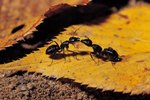
If you've looked at a line of ants marching across your kitchen counter and wondered if they were boys or girls, you were right if you decided on girls. Most ant colonies need far more females than males for the basic reason that females do all the work. With ants, though, it gets complicated.
Girl Ants
In the average ant colony, two kinds of females exist: those who mate and those who don't. The non-mating females are all daughters of the queen. The non-mating females raise the babies, gather the food, maintain and expand the nest, and look after the queen, who does nothing but lay eggs continuously. Queen ants are born to be queens because of a special genetic combination between their parents. These ant princesses have wings, while the sterile female workers do not. Queen ants in some species are bigger than workers; in others you have to look for the difference by examining the thoraxes -- queens have bigger thoraxes with more parts as a result of having wings for part of their lives.
Boy Ants
Males are smaller than females, with smaller heads and longer antennae. They also have wings. Unless you dig into an ant colony, it's unlikely you'll ever see a male ant except on one special hot, humid day in early summer, after the spring rains have passed. That's when all the male ants come out and use their wings in a glorious one-day orgy of free love. In some countries where all ants mate on the same day, this is known as "Flying Ant Day," and is a subject of national interest and even a sort of festival.
Ant Sex
Ants mate in midair. Winged females may mate with several males. In doing this they acquire enough sperm to fertilize all the millions of eggs she can lay over her lifetime, and they ensure that they mate with males from outside their own colonies. Once they mate they drop to the ground and tear off their wings, dig nests and begin new colonies. The males, on the other hand, drop dead soon after mating. One leaf cutter species (Mycocepurus smithii) has evolved to do without sex at all -- the queens clone themselves, while some unmated females lay eggs that produce only winged males, who leave the colony.
Gender War
The question of how many of which gender a colony produces is decided by a sort of competition between the queen and the nursery workers. The queen can fertilize her eggs using stored sperm to produce females or let them go unfertilized and produce males. The nursery worker ants can affect the ratio of males to females by killing some of the male larvae, but they won't kill them all. It depends on which way the queen is slanted -- if a queen who produces mostly males is moved to a colony that produces mostly females, the colony pattern will change to match the queen.
References
- AntBlog: How Can You Tell if an Ant Is Male or Female?
- Japanese Ant Image Database: Winged Ants and Wingless Ants
- University of Arizona, Center for Insect Science Education Outreach: Ant Information
- National Geographic News: Photo in the News: All-Female Ant Species Found
- University of Washington: Conservation: Of Ants and Men
Resources
Photo Credits
-
Jupiterimages/Photos.com/Getty Images



